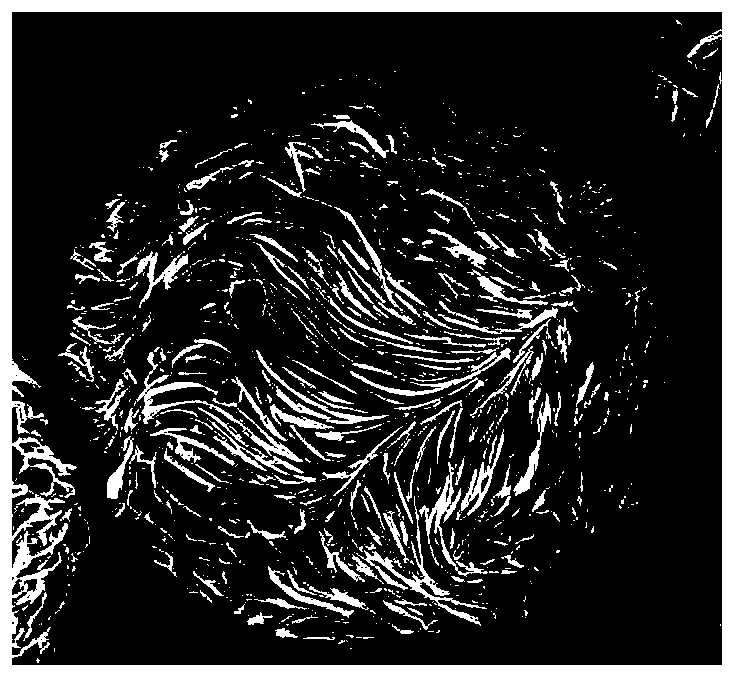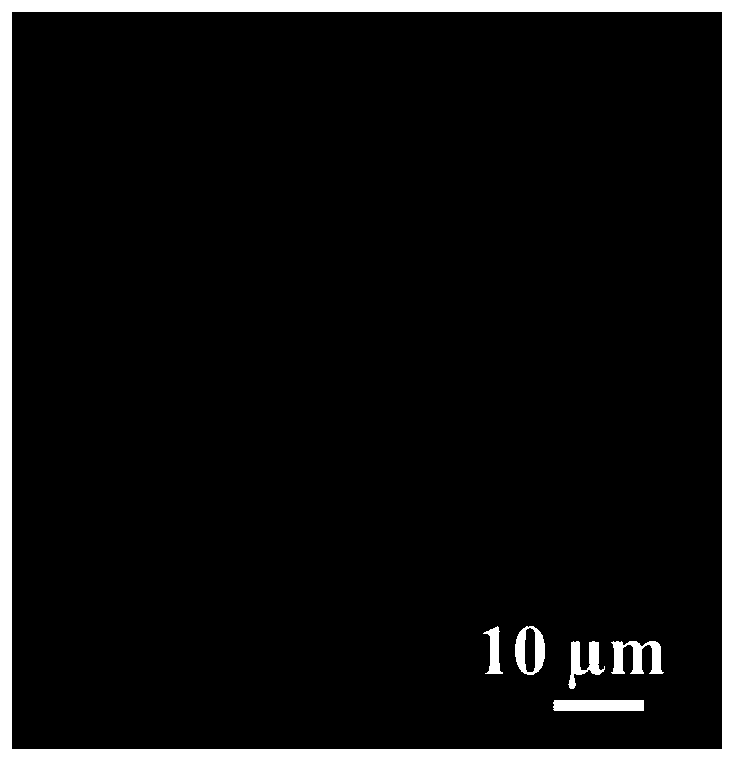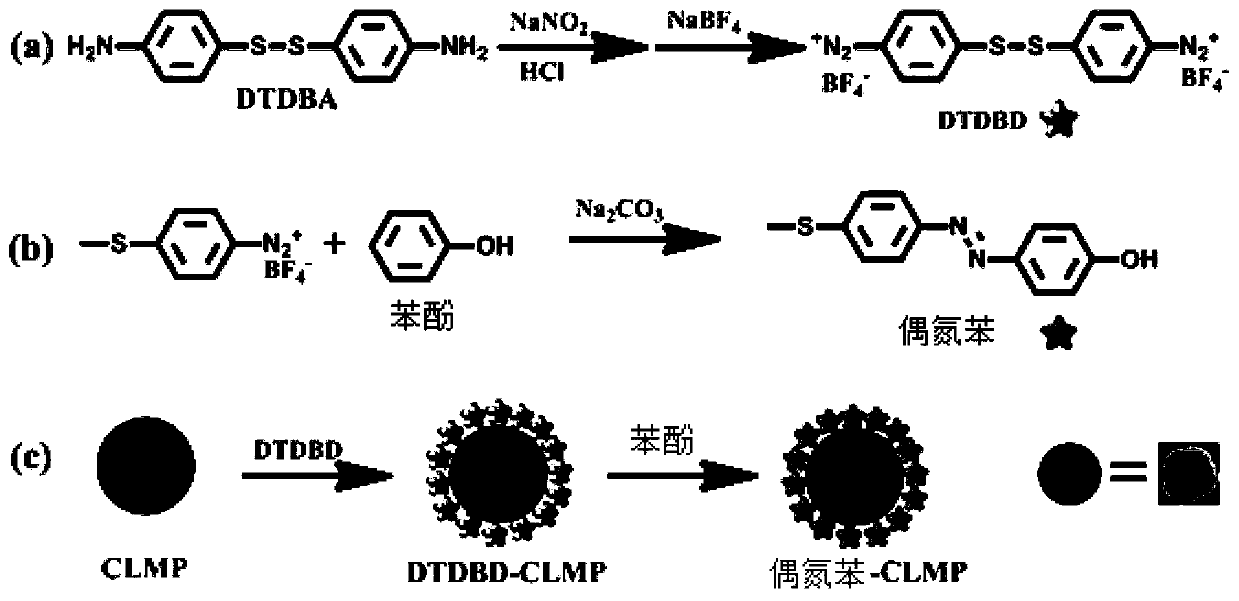Phenol recognition SERS probe, preparation and application thereof, and universal ultra-sensitive immunoassay method based on SERS
A probe and phenol technology, applied in the field of biomolecular detection, can solve the problems of insufficient enhancement of Raman signal, weak spontaneous adsorption, weak Raman signal, etc.
- Summary
- Abstract
- Description
- Claims
- Application Information
AI Technical Summary
Problems solved by technology
Method used
Image
Examples
Embodiment 1
[0080] (1) Synthesis of "cabbage" structure gold microparticles
[0081]Dissolve 8 μL of 10% chloroauric acid aqueous solution in 1 mL of 1 mmol / L hydrochloric acid, add 1.6 mg of PVP, place in ice water for 10 minutes, then add 40 μL of 100 mg / mL NAAN hydrochloric acid aqueous solution, and shake for 20 minutes Leave to react at 4°C for 24 hours; centrifuge at 5000rpm for 10min, wash with NMP after centrifugation to obtain gold microparticles CLMP, then disperse in water to obtain a CLMP aqueous solution with a concentration of 100 / mL, store at 4°C for use. The morphology of the prepared "cabbage" structure gold microparticles CLMP is as follows: figure 1 shown.
[0082] (2) Synthesis of Raman molecules that specifically recognize phenol
[0083] Dissolve 2.82mmol (700mg) DTDBA in 40mL of HCl with a concentration of 1mol / L, cool in an ice water (0°C) bath, then add 2mL of sodium nitrite aqueous solution with a concentration of 3.1mmol / mL while stirring, and place in an ice ...
Embodiment 2
[0088] A SERS detection method for phenol.
[0089] Add 10 μL of the SERS probe aqueous solution prepared in Example 1 to 1 mL of Na 2 CO 3 In aqueous solution, the Na 2 CO 3 The concentration of phenol in the aqueous solution is 1×10 -9 mol / L, 5×10 -9 mol / L, 1×10 -8 mol / L, 5×10 -8 mol / L, 1×10 -7 mol / L, 5×10 -7 mol / L, 1×10 -6 mol / L, 1×10 -5 mol / L, 1×10 -3 mol / L, the Na 2 CO 3 The mass concentration of the aqueous solution was 5%, and then both were incubated at 4°C for 15 min, the probes were collected and washed with water, and the precipitate obtained was then dispersed in water (wherein the content of SERS probes was 100 / mL) to obtain the sample to be tested. A drop of the sample to be tested was drawn and dried at room temperature for 2 h before SERS measurement.
[0090] DTDBD-CLMP and Na 2 CO 3 After incubation with phenol (concentration: 1mmol / L) in aqueous solution, DTDBD reacts with phenol to generate azobenzene, at 1141cm -1 、1391cm -1 and 1438cm -...
Embodiment 3
[0100] A kind of SERS detection method of ALP
[0101] To 950 μL of Tris-HCl buffer (pH 9.8) containing 1 mmol / L PPNa, add 50 μL of different concentrations (0.1 mU / L, 0.5 mU / L, 1 mU / L, 5 mU / L, 10 mU / L , 50mU / L) ALP aqueous solution. Incubate at room temperature for 20 minutes, add 10 μL of the SERS probe aqueous solution prepared in Example 1, and incubate at room temperature for 15 minutes. After washing with water, the resulting precipitate was dispersed in water to obtain the sample to be tested (the content of SERS probes was 100 / mL), and a drop of the sample to be tested was dropped on the silicon wafer, dried at room temperature for 2 hours, and then SERS was measured. .
[0102] The reaction mechanism and detection results of this embodiment are as follows: Figure 7 , 8 , as shown in 9. 1141cm -1 The intensity of the SERS peak at this point was obviously continuously enhanced with the increase of ALP concentration (see Figure 8 ). According to the method of t...
PUM
 Login to View More
Login to View More Abstract
Description
Claims
Application Information
 Login to View More
Login to View More - R&D
- Intellectual Property
- Life Sciences
- Materials
- Tech Scout
- Unparalleled Data Quality
- Higher Quality Content
- 60% Fewer Hallucinations
Browse by: Latest US Patents, China's latest patents, Technical Efficacy Thesaurus, Application Domain, Technology Topic, Popular Technical Reports.
© 2025 PatSnap. All rights reserved.Legal|Privacy policy|Modern Slavery Act Transparency Statement|Sitemap|About US| Contact US: help@patsnap.com



